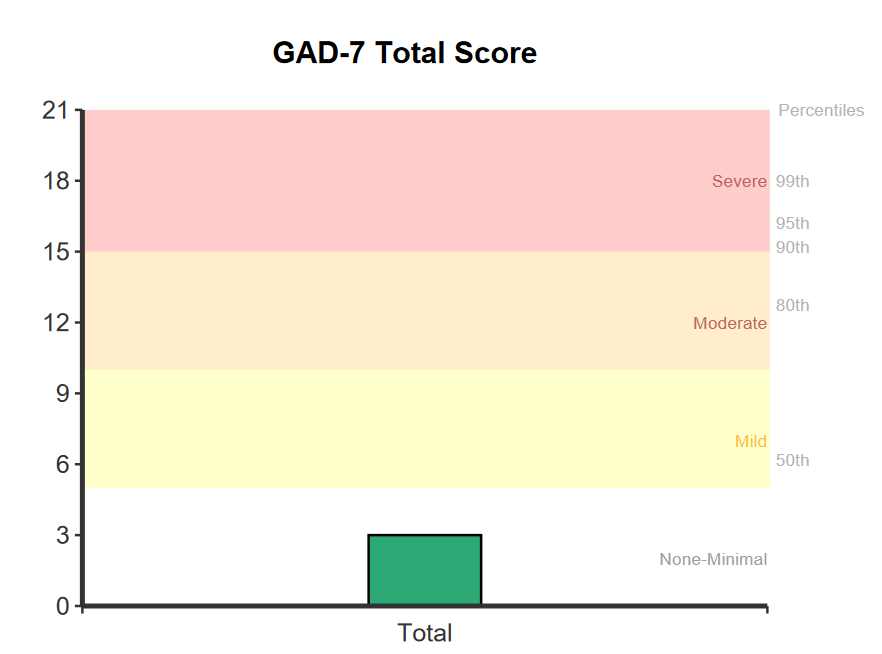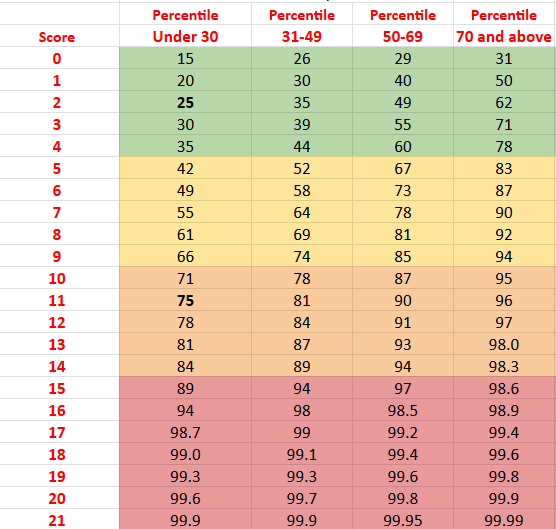The Generalised Anxiety Disorder Assessment (GAD-7) is a brief measure for symptoms of anxiety, based on the generalised anxiety disorder (GAD) diagnostic criteria described in the Diagnostic and Statistical Manual of Mental Disorders (DSM).
GAD is a mental health condition characterised by persistent and excessive worry about various aspects of daily life (American Psychiatric Association, 2013). The GAD-7 assessment asks patients to evaluate their level of symptoms over the last two weeks. When administered on multiple occasions at the start, middle, and end of treatment, responses can be used to track treatment progress over time.
Given the simple language used in the assessment, it is appropriate for individuals as young as 14 years. When used as a screening tool, a score of 10 or greater is associated with Generalised Anxiety Disorder (Sensitivity 89% and Specificity 82%) (Spitzer et al., 2006). However, the GAD-7 is sensitive to anxiety symptoms in general, with scores over 10 also related to other disorders such as panic disorder, social anxiety disorder, and post-traumatic stress disorder (Kroenke, et al. 2007).
A raw score (from 0 to 21) is presented as well as a percentile rank based on a normative community sample (Stocker et al., 2021) of age-related peers. A higher score indicates higher levels of anxiety symptoms.
Percentiles are calculated according to the age of the client and provide a useful context for comparing a respondent’s results with levels of anxiety seen in the community. A percentile of 50 represents typical and relatively healthy patterns of anxiety, falling within the mild range of anxiety for younger age groups (50 years of age or less).

Experiencing at least some anxiety is relatively normal, particularly among younger age groups. Approximately 11% of individuals under 30 fall into the “severe” anxiety range, whereas 1.4% of people over 70 years of age have scores in that range. Given that experiencing anxiety is common, anxiety is best considered on a dimensional basis (e.g. the degree to which someone has symptoms) rather than in a binary absent/present fashion.

The scale classifies individuals into distinct severity categories based on their raw scores, as follows:

When administered multiple times, the total scores are graphed over time.
A significant change in score is defined as an increase or decrease of at least 6 points. This criterion is based on the Reliable Change Index (Bischoff et al., 2020). Such changes indicate significant change symptoms, while a change of less than the specified points indicates minimal change in symptom severity between assessments.
Scores of 10 or greater are indicative of Generalised Anxiety Disorder (Sensitivity 89% and Specificity 82%) (Spitzer et al., 2006) and other psychiatric disorders involving anxiety. Scores of 10 or more may also indicate panic disorder (sensitivity 74%, specificity 81%), social anxiety disorder (sensitivity 72%, specificity 80%), and post-traumatic stress disorder (sensitivity 66%, specificity 81%) (Kroenke, et al. 2007).
Higher scores on the GAD-7 indicate the presence of anxiety symptoms, however 90% of individuals with GAD experience at least one additional psychiatric condition over their lifetime. While major depressive disorder (MDD) is the most prevalent comorbidity among individuals with GAD, dysthymia, bipolar, alcohol abuse are also frequently observed (Simon, 2009; Preti et al., 2015).
Lowe et al. (2008) investigated the validity and reliability of the GAD-7. The normative community sample consisted of a total of 5,036 individuals, with an average age of 48.4 years (SD = 18) and 53.6% of participants being women. Confirmatory factor analyses substantiated the 1-dimensional structure of the GAD-7. Internal consistency was identical across all subgroups (Cronbach’s alpha = 0.89). Intercorrelations with the PHQ-2 and the Rosenberg Self-Esteem Scale were r = 0.64 (p < 0.001) and r = -0.43 (p < 0.001), respectively. Women had significantly higher mean (SD) GAD-7 anxiety scores compared with men [3.2 (3.5) vs. 2.7 (3.2); p < 0.001]. Approximately 5% of subjects had GAD-7 scores of 10 or greater, and 1% had GAD-7 scores of 15 or greater.
The GAD-7 has consistently demonstrated robust psychometric properties across various samples. It has been validated in primary care settings (Spitzer et al., 2006) and population-based samples (Löwe et al., 2008). Recent research aimed to further evaluate its effectiveness in clinical settings. A study by Rutters and Brown (2017) involved 536 patients from the Center for Anxiety and Related Disorders (CARD) at Boston University, with participants averaging 31.49 years of age (SD = 12.05; 62.7% female) and ranging from 18 to 80 years. The study reaffirmed the GAD-7’s unidimensional structure, as a one-factor model fit the clinical data well. The scale exhibited strong reliability with a coefficient of .85 for the full sample and when analysed by gender. Additionally, the GAD-7 demonstrated good convergent validity, showing higher correlations with other anxiety measures, such as the Depression Anxiety and Stress Scale (DASS) – Anxiety (r = .58), DASS – Stress (r = .68), and Penn State Worry Questionnaire (PSWQ) (r = .66), compared to measures of depression like DASS – Depression (r = .48) and Obsessive Compulsive Inventory-Revised (OCD-R) (r = .42).
Normative community percentiles were derived through interpolation using data from an Australian sample of 13,829 individuals, with 75.5% of the participants identifying as female (Stocker et al., 2021). The norms were stratified by age groups as follows:
Using this data and the incidence of people scoring in severity ranges, NovoPsych derived percentile ranks, providing normative benchmarks for comparative purposes.
The following table illustrates how total scores (see Table 1) compare to the normative community sample (Stocker et al., 2021). Each score is accompanied by a corresponding normative community percentile, indicating the percentage of individuals who scored the same or lower in that age group. For example, a score of 6 corresponds to the 49th percentile for individuals under 30 in the normative community. For those aged 31 to 49, a score of 6 is at the 58th percentile. This indicates that 49% of individuals under 30 and 58% of those between 31 and 49 scored 6 or lower in the normative community sample. These graphs help contextualising an individual’s total scores on the GAD-7, providing a clearer understanding of their standing relative to other individuals in the community.
Table 1. GAD-7 Total Score Normative Community Percentiles.

Spitzer, R. L., Kroenke, K., Williams, J. B., & Löwe, B. (2006). A brief measure for assessing generalized anxiety disorder: the GAD-7. Archives of Internal Medicine, 166(10), 1092-1097. https://pubmed.ncbi.nlm.nih.gov/16717171/
American Psychiatric Association. (2013). Diagnostic and statistical manual of mental disorders (5th ed.). https://doi.org/10.1176/appi.books.9780890425596
Bischoff, T., Anderson, S.R., Heafner, J., & Tambling, R. (2020). Establishment of a Reliable Change Index for the GAD-7. Faculty Publications, 8(1), 176-187. https://scholarsarchive.byu.edu/facpub/4117
Kroenke, K., Spitzer, R. L., Williams, J. B. W., Monahan, P. O., & Löwe, B. (2007). Anxiety disorders in primary care: prevalence, impairment, comorbidity, and detection. Annals of Internal Medicine, 146(5), 317–325. https://doi.org/10.7326/0003-4819-146-5-200703060-00004
Löwe, B., Decker, O., Müller, S., Brähler, E., Schellberg, D., Herzog, W., & Herzberg, P. Y. (2008). Validation and Standardization of the Generalized Anxiety Disorder Screener (GAD-7) in the General Population. Medical Care, 46(3), 266–274. https://doi.org/10.1097/mlr.0b013e318160d093
Preti, A., Vrublevska, J., Veroniki, A. A., Huedo-Medina, T. B., & Fountoulakis, K. N. (2016). Prevalence, impact and treatment of generalised anxiety disorder in bipolar disorder: a systematic review and meta-analysis. BMJ Mental Health, 19(3), 73–81. https://doi.org/10.1136/eb-2016-102412
Rutter, L. A., & Brown, T. A. (2017). Psychometric Properties of the Generalized Anxiety Disorder Scale-7 (GAD-7) in Outpatients with Anxiety and Mood Disorders. Journal of Psychopathology and Behavioral Assessment, 39(1), 140–146. https://doi.org/10.1007/s10862-016-9571-9
Simon, N. M. (2009). Generalized anxiety disorder and psychiatric comorbidities such as depression, bipolar disorder, and substance abuse. Journal of Clinical Psychiatry, 70(2), 10-14. https://www.psychiatrist.com/read-pdf/7730/
Spitzer, R. L., Kroenke, K., Williams, J. B., & Löwe, B. (2006). A brief measure for assessing generalized anxiety disorder: the GAD-7. Archives of Internal Medicine, 166(10), 1092-1097. https://pubmed.ncbi.nlm.nih.gov/16717171/
Stocker, R., Tran, T., Hammarberg, K., Nguyen, H., Rowe, H., & Fisher, J. (2021). Patient Health Questionnaire 9 (PHQ-9) and General Anxiety Disorder 7 (GAD-7) data contributed by 13,829 respondents to a national survey about COVID-19 restrictions in Australia. Psychiatry Research, 298, 113792–113792. https://doi.org/10.1016/j.psychres.2021.113792
NovoPsych’s mission is to help mental health services use psychometric science to improve client outcomes.
© 2023 Copyright – NovoPsych – All rights reserved